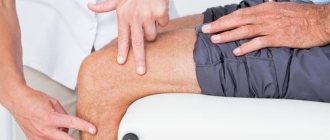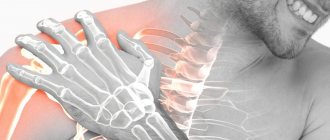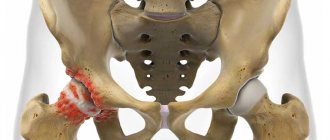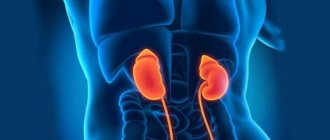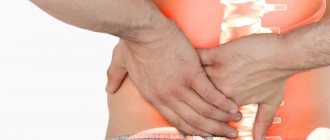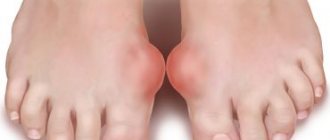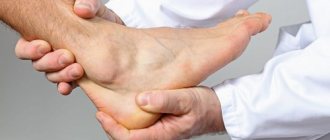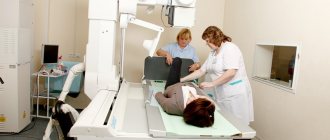The dangers of refusing treatment
If your knees are cracking, you should never ignore the violation. The consequences of untimely treatment can be:
- swelling of the problem area;
- development of pain syndrome;
- joint swelling;
- deformation of the knee structures.
Lack of quality diagnosis and adequate treatment increases the risk of cartilage destruction. In especially severe cases, partial or complete immobility, and even disability, occurs.
The appearance of a crunch in the knees requires a mandatory visit to the doctor. Only an experienced specialist will be able to determine the factor that caused the development of the pathology.
Joint diagnostics
In order to identify the factors that provoked the development of the disease and detect hidden pathology, diagnostics are performed. To do this, resort to the following methods:
- Ultrasound examination of joints;
- X-ray;
- CT or MRI;
- Puncture;
- Lab tests.
Make an appointment Online booking
- Clinic on Krasnopresnenskaya +7 (499) 252-41-35 Volkov lane, 21
- Clinic on Varshavskaya +7 (499) 610-02-09 Varshavskoe highway, 75, building 1
- Clinic in Annino +7 (495) 388-08-08 Varshavskoe highway, 154, building 1
How to treat crunchy knees?
If your knees are cracking, you need to decide what to do together with your doctor. Before selecting an effective treatment for the patient, the specialist will conduct a detailed diagnosis and clarify the presence of associated disorders.
At the initial stage of the pathology, drug therapy is prescribed, based on the use of local drugs. If such remedies do not lead to the disappearance of negative symptoms, there is a need for complex therapy.
Local painkillers
Products for topical use (ointments, gels) can relieve pain and eliminate the inflammatory process. Effective medications for knee crunch include:
- Indomethacin.
- Ortofen.
- Artrosilene.
- Diclofenac.
- Nise gel.
- Fastum gel.
The listed medications are intended for daily use. On average, a treatment course with such medications takes at least two weeks.
Knee injections
Injections are most often prescribed if knee crunch is associated with diseases such as arthrosis, gout or bursitis. Also, injections become necessary if there is severe pain.
Therapy is based on the use of corticosteroids (Ketorolac), drugs based on hyaluron (Hyalux), chondroprotectors (Chondrolone).
After injection into the joint, such medications enter the synovial fluid. Injections act directly on cartilage and joint tissue, relieve discomfort, and promote faster recovery.
Tablets and capsules
Patients who have pain and a crunch in their knee are advised to take internal medications such as non-steroids and chondroprotectors. The use of such drugs as Meloxicam, Karipain, Structum, Teraflex has a positive effect. Aspirin is widely used in the treatment of knee joints, helping to relieve inflammation and swelling and slow down the destruction of cartilage.
The duration of the medication course is determined individually, based on the severity of the existing symptoms. To have a strengthening effect on the entire musculoskeletal system, additional vitamin and mineral complexes and dietary supplements are prescribed.
Physiotherapy
Among the most effective physiotherapeutic procedures are:
- electrophoresis, during which medications are delivered to the joint under the influence of an electric current;
- UHF is a method that affects the pathological area with electric field pulses;
- laser therapy based on the use of infrared rays;
- ultraviolet irradiation (UV);
- inductothermy, the essence of which is the use of a magnetic field.
The listed methods increase blood circulation in the area of the problem joint, accelerate the removal of harmful substances, and activate regeneration processes. Thanks to a full course of physiotherapy, it is possible to accelerate the onset of remission and avoid relapse of the disease.
Exercise therapy and diet
Therapeutic exercise relieves discomfort, accelerates metabolism, and improves nutrition of joint tissue. Specific training should be performed daily. A set of exercises is prescribed by a doctor, in the absence of certain contraindications.
A diet for crunchy knees involves eliminating spicy, sweet, canned, and animal foods from the diet. Seafood, grains, a variety of fruits and vegetables, fresh herbs, low-fat milk and fermented milk products are beneficial.
To ensure normal production of lubricant in the joints, it is important to drink sufficient amounts of fluid. At the same time, you should refrain from strong coffee and tea, give preference to clean water without gas, natural juices, fruit drinks, and compotes.
Causes of crunching in joints
Factors that cause crunching in the joints (crepitus) include:
- Genetic characteristics of connective tissue. The elasticity of the joint capsule and ligaments can be influenced by hereditary characteristics. In some individuals, there is increased joint flexibility. If a person has the ability to extend a limb more than 180 degrees, the crunch can be caused by anatomical factors. Genetic causes also include insufficient formation of synovial fluid in the joints;
- Dioxide bubbles. The joint lubrication that forms in the joint can trigger the production of gas bubbles. As a result, in the event of sudden unloading of the limb, a characteristic pop appears in the area of the knee joint;
- Tendon displacement. Occurs during motor activity of the joint. Returning to its original position, it can provoke clicks. A similar phenomenon occurs in persons in the age group from 12 to 19 years;
- Rapid development during adolescence. As is known, adolescents experience spasmodic growth, which can lead to an imbalance in the proportions of the torso. However, the joints are not able to quickly adapt to such changes. If the teenager does not have other pathological processes, one can hope that the crunching in the joints will disappear by the age of 18-24;
- Developmental defects. There may be a discrepancy between the articular surfaces, with the extreme part of the bones extending beyond the limits of the articular capsule, which contributes to the appearance of a crunch. It should be noted that many pathologies of the musculoskeletal system can provoke a crunch in the knee joint, which specialists can detect in a child under the age of 7 years;
- Hormonal imbalances and metabolic disorders. We are talking about changes associated with age-related factors (menopause in men and women), autoimmune diseases and other hormonal causes that negatively affect joint flexibility. Also, crunching in joints throughout the body can be caused by salt deposits due to metabolic pathologies of various types;
- Use of hormonal therapy. Tablet contraceptives and glucocorticoid drugs can cause crunching in the joints of the fingers and other parts of the body. You can cope with it after completing the above remedies;
- Injury or increased physical activity. If a crunch in the shoulder or any other joint occurs as a result of injury, you should contact an experienced specialist. Common dehydration of the joint often occurs due to the absence of the articular ligament. In this situation, you should minimize the load on the affected limb and, for 14-20 days, take medications for crunching in the joints. If discomfort makes itself felt due to wear and tear of the joint, a prerequisite is to consult a rheumatologist;
- Lack of mobility for a long period of time. In order for the natural formation of synovial fluid, an optimal load must be placed on the joint. With physical inactivity, the normal sliding of the joint is disrupted and a characteristic crunch appears. If the factor causing stiffness in the joint is injury, you should visit a specialist involved in restoring its functionality;
- Age-related pathologies. Persons in the age group over 60 years of age are more often than others susceptible to progressive metabolic disorders in the cartilage tissue of joints and inflammatory processes in nearby muscles.
Also, discomfort and crunching in the joint area can be caused by uneven load, which is a consequence of obesity, wearing uncomfortable shoes and prolonged work in an uncomfortable position.
When is surgery required?
If there is severe crunching in the knees, treatment may include surgical methods. The operation is mainly required for patients with complex injuries.
This procedure is also used if restoration of the joint is considered impossible. In such cases, specialists perform arthroplasty, arthroscopy or prosthetics.
Kinesitherapy for the treatment of crunchy knees
Kinesitherapy allows you to completely eliminate unpleasant creaking in the knees, prevent possible complications, and avoid the need for surgery. The method is used with great success in our center.
Patients note its high effectiveness, complete safety and comfort. Thanks to the sessions, it is possible to gradually stop taking medications or reduce their amount. In addition to improving the health of the problem joint, kinesitherapy has a beneficial effect on the entire body and relieves associated pathologies.
Our centers offer effective medical care in different cities of Russia. We work in Dubna, Tver, Zelenograd, Klin. Kinesitherapy brings relief at any age, does not have many contraindications, and significantly reduces the risk of recurrence of the disease.
Doctors' recommendations for cracking joints
If there is no focus of inflammation, but a characteristic crunch in the joints, you should not look for the causes of the disease and demand that effective treatment be prescribed. Experts recommend following the usual preventive measures:
- Take plenty of water. This will reduce blood viscosity and ensure a rapid supply of nutrients to the joint area;
- Provide optimal load. By performing proper physical exercises, it is possible to quickly enrich tissues with nutrients. The highest priorities are visiting the swimming pool and race walking. Experts do not recommend jogging. In this case, light gymnastics will not be superfluous;
- Prolonged idle time on both lower extremities should be avoided. In addition, if you have cracking joints, it is not advisable to do jumping and squats;
- Balanced diet. A prerequisite for recovery in such pathologies is the consumption of jellied meat and fish soups;
- If the disease was caused by excessive salt deposits, it is necessary to exclude canned food, fatty meat soups, smoked meats and fatty fish from the daily diet. You should also remember the need to take vitamins A and D, as well as calcium, which allows you to quickly restore cartilage tissue.
MESSAGE FROM THE CHIEF DOCTOR:
Often, when examining a patient, doctors pay attention only to the bones, ligaments, and joints. At the same time, nothing is said about muscles
, the function of contraction of which plays a significant role in human life. Weakened muscles lead to thinning and deformed bones.
Unfortunately, common methods of therapy only aggravate the situation, leading to even more severe pain, muscle atrophy and a deterioration in the quality of life of patients.
Effective treatment is impossible to imagine without muscle restoration. Unique kinesitherapy technique
consists in a therapeutic effect, which implies, first of all, muscle activity during the methodical execution of a set of exercises on special simulators.
All exercises are performed by patients sitting or lying down, so there is no excessive stress on the joints and circulatory system, and our instructors-methodologists correct the technique of movements
and monitor the correct execution of actions.
Remember that diseases of the spine and joints are not a death sentence; if the patient wishes and the right approach to treatment, everything can be corrected!
When is a visit to the doctor urgent for cracking joints?
It should be noted that crunching in the joints itself is not considered a pathological process. Causes for concern may arise only if the following signs are detected:
- Sensation of friction between the heads of bones;
- Painful manifestations that intensify during physical activity;
- Muscle cramps even in the absence of movement;
- The appearance of swelling in the joint and soft tissues;
- Decreased motor activity in the joint;
- Sensation of a foreign body in the synovial bursa;
- The appearance of redness just below the knee joint, local temperature increase;
- Weakness and loss of sensation in the muscle area.
It should be noted that the periodic occurrence of crackling is a completely normal phenomenon. In turn, pathology is indicated by a regular, gradually increasing, rough crunch.
